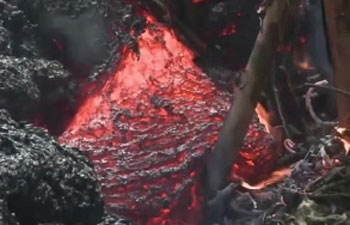LOS ANGELES, May 14 (Xinhua) -- The U.S. National Aeronautics and Space Administration (NASA) is set to launch a pair of next-generation Earth research satellites later this month to continue the legacy of the first Gravity Recovery and Climate Experiment (GRACE) mission in recording the Earth's climate data, including the key movement of water.
The pair of new satellites, part of NASA's new mission called GRACE Follow-On (GRACE-FO), scheduled to take off on May 19, to relay the important task of GRACE in directly measuring global changes in the water stored underground in the world's largest aquifers.
The pair will be launched from Vandenberg Air Force Base in California as part of a commercial rideshare mission with five Iridium Communications Inc. satellites aboard a SpaceX Falcon 9 rocket, after its predecessor GRACE ended its mission in 2017.
GRACE-FO, like GRACE, is designed to measure changes in gravitational pull that result from changes in mass on Earth. It will continue monitoring monthly changes in the distribution of mass in Earth's atmosphere, oceans, land and ice sheets, and the solid Earth itself.
The data will provide a unique view of Earth's changing climate, Earth system processes and even the impacts of some human activities, and will have far-reaching benefits to society, such as improving water management.
Like GRACE, the twin spacecraft will use an innovative technique to observe something that can't be seen directly from space.
It uses the weight of water to measure water's movement, even water hidden far underneath Earth's surface. GRACE-FO will do this by precisely measuring the changes in the shape of Earth's gravity field caused by the movement of massive amounts of water, ice, and solid Earth.
It's measurements of changes in water stored underground will be used for producing the U.S. Drought Monitor's weekly maps, one of the nation's most important tools for tracking drought nationwide. The maps are widely used by decision makers at federal and state levels.
Researchers prepared experimental drought indicators from downscaled data each week from 2011 until the GRACE mission ended in October 2017.
"GRACE covers the entire country, and it helps us to get an idea of where areas of wetness and dryness are," said climatologist Brian Fuchs of U.S. National Drought Mitigation Center (NDMC), one of the team of scientists who produce drought maps.
Because the GRACE mission ended after the end of the growing season last fall, Fuchs said that its loss has not yet been strongly felt by the Drought Monitor mappers.
"We would be looking for GRACE in the growing season, where soil moisture is pertinent to determining crops and vegetation," he said, noting people will urgently need such data in a couple more months.
Those people will most likely have their answer before the 2019 growing season, as GRACE Follow-On begins delivering monthly maps.
Fuchs said: "If it's going to behave as GRACE did in the past, it will be a valuable asset."
GRACE-FO will extend the GRACE data record for an additional five years and expand its legacy of scientific achievements.
The new mission will provide invaluable observations of long-term climate-related mass changes, said Frank Webb, GRACE-FO project scientist at NASA's Jet Propulsion Laboratory (JPL) in Pasadena, California.
"The only way to know for sure whether observed multi-year trends represent long-term changes in mass balance is to extend the length of the observations," Webb said.
JPL manages the GRACE-FO mission for NASA's Science Mission Directorate in Washington, under the direction of the Earth Systematic Missions Program Office at NASA's Goddard Space Flight Center in Greenbelt, Maryland.
GRACE-FO were built by Airbus Defence and Space in Friedrichshafen, Germany, under subcontract with JPL.













